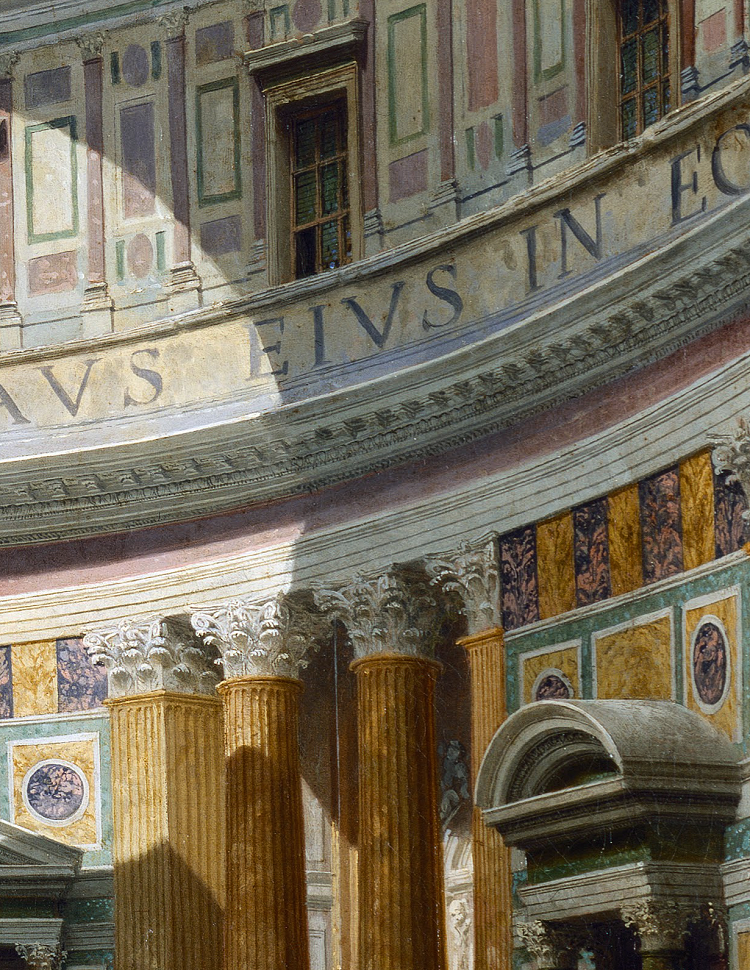In Panini's day, as in our own, the Pantheon was one of the great tourist attractions of Rome. Built under Hadrian in the 2nd century, this monumental domed temple has survived intact, owing to its consecration as a Christian church—Santa Maria Rotunda—in AD 609. Panini's depiction is populated with foreign visitors and a lively mix of Romans from all social strata who congregate in the Pantheon to pray, to chat, and to admire the wondrous architecture.
Trained in architecture and theatrical design, Panini manipulated the perspective to show a larger view of the interior than is actually possible from any single place. The viewpoint is deep within the building, facing the entrance. The portals open to the colossal columns of the porch and a glimpse of the obelisk in the piazza before the church. Through the oculus in the center of the dome, Panini revealed the bright blue sky flecked with clouds.
As Canaletto was to Venice, so Panini was to Rome. Both artists documented with exacting skill and vibrancy the monuments of their cities and the daily comings and goings of the inhabitants. In this case, Panini depicted the classical landmark that inspired the design of the Rotunda in the National Gallery's West Building.
Giovanni Paolo Panini, the most celebrated and popular view painter in eighteenth-century Rome, was born 17 June 1691 in Piacenza. Although he prepared as a youth for a career in the Church, he studied perspective and architectural painting in his native city and had received some architectural training by the time of his arrival in Rome in November 1711. Although already recognized as an independent painter of landscapes and architectural and perspective views, Panini attended the drawing academy of the figure painter Benedetto Luti until about 1717-1718. The formative influences upon his style were the classical ruin paintings of Giovanni Ghisolfi, the landscapes of Jan Van Bloemen and Andrea Locatelli, and the topographical views of Gaspar Van Wittel (1653-1736).
In his early years Panini established himself principally as a fresco decorator of the villas and palaces of the Roman ecclesiastical intelligentsia and aristocracy. In 1718 Panini was elected to the Congregazione dei Virtuosi al Pantheon and in 1719 to the Accademia di San Luca in Rome; in 1754 and 1755 he served as the Academy's president, or principe. Panini's associations with the French in Rome advanced his career significantly, particularly after 1724 when he married the sister-in-law of Nicolas Vleughels, director of the Académie de France at Rome. Panini taught perspective there and in 1732 was received as a member of the Académie royale de peinture et de sculpture in Paris, an honor accorded few Roman artists. Patronized by Cardinal Melchior de Polignac, Louis XV's chargé d'affaires in Rome from 1724 to 1732, and by the Duc de Choiseul, French Ambassador to Benedict XIV, he influenced younger French painters like Claude-Joseph Vernet, Hubert Robert, and Jean-Nicolas Servandoni, who traveled to Rome to complete their education.
Although Panini worked as an architect, designing Cardinal Valenti's villa and the chapel in Santa Maria della Scala (1728), and produced fireworks, festival apparatuses, and other ephemeral architectural decorations (and painted magnificent records of them), in the last thirty years of his life he specialized in painting the views of Rome that secured his lasting reputation. These were of two main types, vedute prese da i luoghi (carefully and accurately rendered views of actual places) and vedute ideate (imaginary views and combinations of particular buildings and monuments). His views of ancient and modern Rome encompassed practically everything worth noting in the eighteenth-century guidebooks to the Eternal City. These paintings were not idealized or symbolic representations of Rome's past and present grandeur, but accurate and objective portrayals of the most famous, most picturesque, or most memorable sights of the city. In the 1740s and 1750s, Panini produced numerous views of ancient and contemporary Rome to meet the growing demand for such highly commercial paintings created by foreign visitors to the city on the Grand Tour. The popularity of his paintings among the British in particular is confirmed by the the large number of paintings (and many replicas and copies) with a British provenance.
In addition to the view paintings for which he is best known, Panini produced religious and historical scenes, records of contemporary historical events, real and imaginary architectural pieces, and fantasy views of Roman ruins. The tremendous size of Panini's oeuvre, the number of extant versions of certain compositions, and the mechanized and routine handling characterizing many of these canvases confirm that he relied upon an extensive workshop to produce reproductions of his more popular compositions. Panini's son Francesco served as his principal studio assistant and, after the artist's death in Rome on October 21, 1765, supplied drawings after his compositions to engravers.













No comments:
Post a Comment